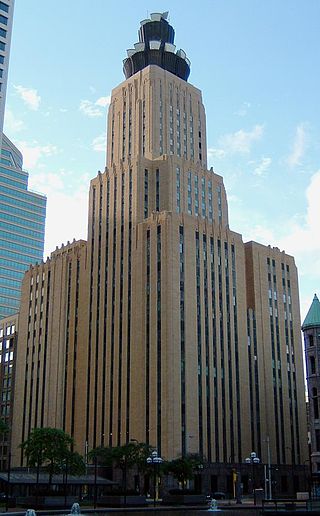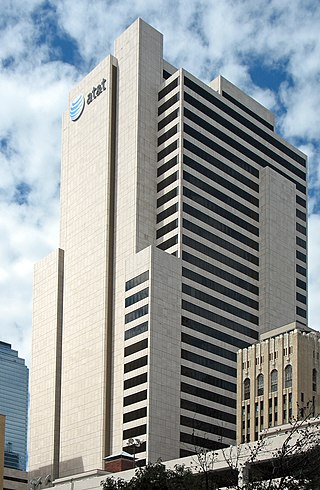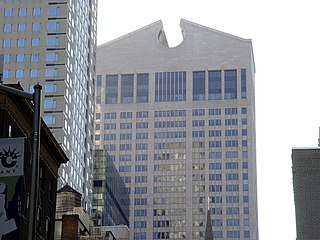
Alexander Graham Bell was a Scottish-born Canadian-American inventor, scientist, and engineer who is credited with patenting the first practical telephone. He also co-founded the American Telephone and Telegraph Company (AT&T) in 1885.

Dual-tone multi-frequency signaling (DTMF) is a telecommunication signaling system using the voice-frequency band over telephone lines between telephone equipment and other communications devices and switching centers. DTMF was first developed in the Bell System in the United States, and became known under the trademark Touch-Tone for use in push-button telephones supplied to telephone customers, starting in 1963. DTMF is standardized as ITU-T Recommendation Q.23. It is also known in the UK as MF4.

A Regional Bell Operating Company (RBOC) was a corporate entity created as result of the antitrust lawsuit by the U.S. Department of Justice against the American Telephone and Telegraph Company (AT&T) in 1974 and settled in the Modification of Final Judgment on January 8, 1982.

BellSouth, LLC was an American telecommunications holding company based in Atlanta, Georgia. BellSouth was one of the seven original Regional Bell Operating Companies after the U.S. Department of Justice forced the American Telephone & Telegraph Company to divest itself of its regional telephone companies on January 1, 1984.
Bell MTS Inc. is a subsidiary of BCE Inc. that operates telecommunications services in Manitoba.

Cincinnati Bell, Inc., doing business as Altafiber, is a regional telecommunications service provider based in Cincinnati, Ohio, United States. It provides landline telephone, fiber-optic Internet, and IPTV services through its subsidiaries Altafiber Home Phone and Hawaiian Telcom, which are the incumbent local exchange carriers for the Greater Cincinnati metropolitan area and Hawaii. Other subsidiaries provide enterprise information technology services and long distance calling.
In telecommunications, a long-distance call (U.S.) or trunk call is a telephone call made to a location outside a defined local calling area. Long-distance calls are typically charged a higher billing rate than local calls. The term is not necessarily synonymous with placing calls to another telephone area code.
Northwestel Inc. is a Canadian telecommunications company that is the incumbent local exchange carrier (ILEC) and long-distance carrier in the territories of Yukon, the Northwest Territories, Nunavut, and part of Northern British Columbia. Originally established in 1979 by the Canadian National Railway from CN's northern telecommunications assets, it has been owned by BCE Inc. since 1988.

The monopoly position of the Bell System in the U.S. was ended on January 8, 1982, by a consent decree providing that AT&T Corporation would, as had been initially proposed by AT&T, relinquish control of the Bell Operating Companies, which had provided local telephone service in the United States. AT&T would continue to be a provider of long-distance service, while the now-independent Regional Bell Operating Companies (RBOCs), nicknamed the "Baby Bells", would provide local service, and would no longer be directly supplied with equipment from AT&T subsidiary Western Electric.

Verizon New Jersey, Inc., formerly New Jersey Bell Telephone Company, is the Bell Operating Company serving the U.S. state of New Jersey. In 1984, the Bell System Divestiture split New Jersey Bell off into a Regional Bell Operating Company, along with the 21 other BOCs AT&T had a majority stake in. On January 1, 1984, New Jersey Bell became part of Bell Atlantic.

AT&T Labs, Inc. is the research & development division of AT&T, the telecommunications company. It employs some 1,800 people in various locations, including: Bedminster NJ; Middletown, NJ; Manhattan, NY; Warrenville, IL; Austin, TX; Dallas, TX; Atlanta, GA; San Francisco, CA; San Ramon, CA; and Redmond, WA. The main research division, made up of around 450 people, is based across the Bedminster, Middletown, San Francisco, and Manhattan locations.

The Lumen Technologies Building in Minneapolis, Minnesota was completed in 1932 and became the tallest building to be built in the city during the 1930s, 1940s, and 1950s. Named for its current owner, it was previously known as the CenturyLink Building, Qwest Building and the Northwestern Bell Telephone Building. Originally standing 346 feet (105 m) tall, the structure grew to 416 feet (127 m) with the addition of a microwave antenna "crown" in 1958, followed by the addition of a second tier of microwave antennas in 1972. The antennas, which were used for AT&T Long Lines, were removed in 2019. It was the second-tallest building in the city after the slightly older Foshay Tower for many years, and stands slightly taller than the tower of its neighbor, Minneapolis City Hall.
SBC Long Distance LLC is a long-distance telephone company owned by AT&T that does business as AT&T Long Distance. SBC Long Distance competes with other long-distance providers who provide service within some of the Bell Operating Company service boundaries of AT&T. SBC Long Distance is a separate subsidiary than AT&T Communications, the incumbent long-distance carrier for most of the country acquired in the SBC merger with AT&T.
This article contains an overview of the year 1980 in athletics. The major athletics event of the year was the 1980 Moscow Olympics. A boycott of this competition meant many of world's leading athletes did not face each other, with many of the boycotting athletes taking part in the rival Liberty Bell Classic competition.

AT&T Inc. is an American multinational telecommunications holding company headquartered at Whitacre Tower in Downtown Dallas, Texas. It is the world's third-largest telecommunications company by revenue and the second-largest wireless carrier in the United States behind Verizon but ahead of T-Mobile. As of 2023, AT&T was ranked 13th on the Fortune 500 rankings of the largest United States corporations, with revenues of $122.4 billion.

Qwest Communications International, Inc. was a United States telecommunications carrier. Qwest provided local service in 14 western and midwestern U.S. states: Arizona, Colorado, Idaho, Iowa, Minnesota, Montana, Nebraska, New Mexico, North Dakota, Oregon, South Dakota, Texas, Utah, Washington, and Wyoming.

The Bell System was a system of telecommunication companies, led by the Bell Telephone Company and later by the American Telephone and Telegraph Company (AT&T), that dominated the telephone services industry in North America for over 100 years from its creation in 1877 until its antitrust breakup in 1983. The system of companies was often colloquially called Ma Bell, as it held a vertical monopoly over telecommunication products and services in most areas of the United States and Canada. At the time of the breakup of the Bell System in the early 1980s, it had assets of $150 billion and employed over one million people.

AT&T Corporation, commonly referred to as AT&T, an abbreviation for its former name, the American Telephone and Telegraph Company, was an American telecommunications company that provided voice, video, data, and Internet telecommunications and professional services to businesses, consumers, and government agencies.
Frontier West Virginia, Inc. is one of the original Bell Operating Companies and provides local telephone service in the U.S. state of West Virginia.
The history of AT&T dates back to the invention of the telephone. The Bell Telephone Company was established in 1877 by Alexander Graham Bell, who obtained the first US patent for the telephone, and his father-in-law, Gardiner Greene Hubbard. Bell and Hubbard also established American Telephone and Telegraph Company in 1885, which acquired the Bell Telephone Company and became the primary telephone company in the United States. This company maintained an effective monopoly on local telephone service in the United States until anti-trust regulators agreed to allow AT&T to retain Western Electric and enter general trades computer manufacture and sales in return for its offer to split the Bell System by divesting itself of ownership of the Bell Operating Companies in 1982.











